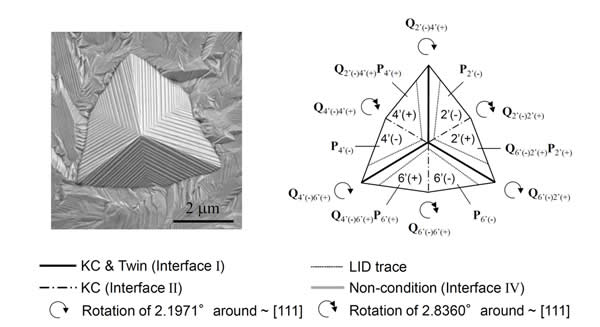The TiNi shape memory alloy (SMA) can recover its shape even after deformation of a few percent. The behavior indicates the shape memory effect and superelasticity.
This unique property originates in ‘domain-switching’ of the low-temperature phase (B19': monoclinic). However, the nature of the real domain structure had been unclear.
Now, Tomonari Inamura and colleagues at Tokyo Institute of Technology and Kyushu University have shown that the real domain structure is ‘twisted’ unlike the traditional model.
The domain structure was observed by scanning electron microscopy (Carl Zeiss Ultra 55) and transmission electron microscopy (JEOL ARM200F). The results were analyzed by a new method using the geometrically nonlinear theory of deformation.
Four types of preferential morphology for the domain structure were identified. The structure formed by six domains has the lowest torsion at the domain wall.
Tuning the alloy composition to enhance the six-domain structure is expected to be effective for decreasing hysteresis and improving fatigue strength. These properties are necessary for medical applications and waste heat recovery technologies.
Reference
- Authors: Tomonari Inamura1, Tomohiro Nishiura2, Hideto Kawano2, Hideki Hosoda1 and Minoru Nishida3
- Title of original paper: Self-accommodation of B19' martensite in Ti-Ni shape memory alloys. Part III. Analysis of habit plane variant clusters by the geometrically nonlinear theory
- Journal, volume, pages and year: Philosophical Magazine 92, 2247-2263 (2012).
- Digital Object Identifier (DOI): 10.1080/14786435.2012.669859
- Affiliations: 1Precision and Intelligence Laboratory, Tokyo Institute of Technology, Japan.
2Interdisciplinary Graduate School of Science and Engineering, Kyushu University, Japan
3Department of Engineering Science for Electronics and Materials, Kyushu University, Japan
- Department website: http://www.igs.titech.ac.jp/english/departments/iem.html


The six-domain structure in TiNi
. Any information published on this site will be valid in relation to Science Tokyo.



